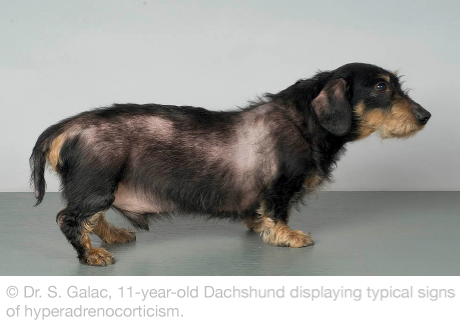Diagnosing Cushing's
The symptoms of hyperadrenocorticism (HAC) are fairly non-specific and never conclusive for diagnosing the disease. However, clinical signs and patient history remain the best way to determine the occurrence of HAC and the first step in the diagnosis process.
- Polydipsia
- Polyuria
- Polyphagia
- Hypertension
- Pot belly
- Thinning of the skin
- Hair loss
- Recurrent skin diseases
- Lethargy
- Excessive panting
Other less common clinical signs include*:
- Heat intolerance
- Seborrhea
- Comedones
- Hyperpigmentation
- Calcinosis cutis
- Bruising
- Testicular atrophy
- Failure to cycle
- Clitoral hypertrophy
- Facial paralysis

Some signs of Cushing’s syndrome may be confused with normal aging, which can make it particularly difficult to diagnose. Several tests are available to aid in the diagnosis of Cushing's syndrome. However, because cortisol levels in the blood of both normal dogs and dogs with hyperadrenocorticism fluctuate greatly throughout the day, a diagnosis cannot be confirmed by simply measuring the concentration of cortisol in the blood.
Further help can be obtained by contacting Dechra Veterinary Technical Services at (855) 332-9334 or technical.ca@dechra.com.
*Reusch CE (2005). Hyperadrenocorticism. Textbook of Veterinary Internal Medicine, 6th Ed., Ed SJ Ettinger, EC Feldman, pp. 1592-1612.
